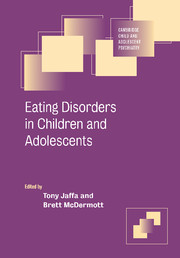Book contents
- Frontmatter
- Contents
- List of Contributors
- Part I Introduction
- Part II Scientific underpinnings
- Part III Abnormal states
- Part IV Evidence-based care
- 16 Assessment and treatment of acute medical complications during the refeeding process
- 17 Assessment and treatment of chronic medical complications
- 18 Individual psychotherapy
- 19 Evidence-based family psychotherapy interventions
- 20 Models of service delivery
- 21 Psychopharmacology and eating disorders
- Part V Public health perspectives
- Index
- References
19 - Evidence-based family psychotherapy interventions
from Part IV - Evidence-based care
Published online by Cambridge University Press: 02 December 2009
- Frontmatter
- Contents
- List of Contributors
- Part I Introduction
- Part II Scientific underpinnings
- Part III Abnormal states
- Part IV Evidence-based care
- 16 Assessment and treatment of acute medical complications during the refeeding process
- 17 Assessment and treatment of chronic medical complications
- 18 Individual psychotherapy
- 19 Evidence-based family psychotherapy interventions
- 20 Models of service delivery
- 21 Psychopharmacology and eating disorders
- Part V Public health perspectives
- Index
- References
Summary
The role of families in treating this disorder was debated by the two individuals who first described anorexia nervosa (AN), William Gull in England and E. C. Lasègue in France. Gull suggested that families were the ‘worst attendants’ for their children with AN (Gull, 1874), whereas Lasègue believed the family to be essential to recovery and recommended their involvement (Lasègue, 1883). Specific family interventions for eating disorders started with Salvador Minuchin (Minuchin et al., 1975) and Mara Selvini–Palazzoli (Selvini, 1974). Hilde Bruch also provided a theory to support the use of family-based interventions, proposing that as a child, insufficient and inaccurate feedback was given by the mother, resulting in a distorted perception of self, a pervasive sense of ineffectiveness and poorly developed interoceptive awareness (Bruch, 1973; Dare & Eisler, 2002). More recently, family-based interventions have been gaining in popularity due to a growing evidence base.
Currently, there are many different views on the families of patients with eating disorders. Some believe that dysfunctional family systems are the cause of eating pathology, whereas others believe that the eating disorder brings about family dysfunction. Perhaps partly due to the success of early family therapists (e.g. Minuchin and Palazzoli) it appeared that AN originated in family disturbances that could be treated by targeting these supposed causative factors in family therapy. However, there have been no longitudinal studies that have investigated whether family dysfunction precedes or follows the onset of eating disorders.
Keywords
- Type
- Chapter
- Information
- Eating Disorders in Children and Adolescents , pp. 238 - 247Publisher: Cambridge University PressPrint publication year: 2006

